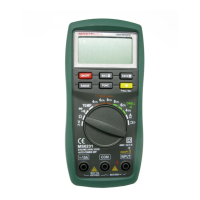the higher range has to be selected.
( At the manual range mode, when the value scale to be measured is unknown beforehand, set the range
selector at the highest position.
( Select the AC clamp to measure the AC current.
( Matching problem about the meter and the sensitivity of the clamp:
a. The sensitivity of 200A range is 200mV, that of 2000A is 2V; the sensitivity of the matching clamp is
0.1A/0.1mV. The present indicated value is same to the measured value.
b. If the sensitivity of the selected clamp is low (0.1A/0.01mV), the indicate value will be 10 times lower
than the measured value. For example, the measured current is 100A, then the indicated value will be
10.0A.
c. If the sensitivity of the selected clamp is high (0.1A/1mV), the indicated value will be 10 times higher
than the measured value. For example, the measured current is 100A, then the indicated value will be
1000A.
4.16 MEASURING RESISTANCE
WARNING
When measuring in-circuit resistance, be sure
the circuit under test has all power removed and
that all capacitors have been discharged fully.
4.16.1 Connect the black test lead to the COM jack and the red test lead to the INPUT jack.
4.16.2 Set the transform switch at the ( range position. Auto range or manual range can be transformed
by putting the “ RANGE ” .
4.16.3 Connect test leads across the resistance under measurement.
4.16.4 You can get reading from LCD.
NOTE:
( At the manual range mode, when only the figure ‘ OL
’
is displayed, it indicates overrange situation and
the higher range has to be selected.
( For measuring resistance above 1M ( , the meter may take a few seconds to get stable reading.
( When the input is not connected, i.e. at open circuit, the figure ‘ 1
’
will be displayed for the overrange
condition.

